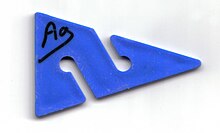Line marker
In cave (and occasionally wreck) diving, line markers are used for orientation as a visual and tactile reference on a permanent guideline. Directional markers (commonly arrows), are also known as line arrows or Dorff arrows, and point the way to an exit. Line arrows may mark the location of a "jump" location in a cave when two are placed adjacent to each other. Two adjacent arrows facing away from each other, mark a point in the cave where the diver is equidistant from two exits. Arrow direction can be identified by feel in low visibility.
Non-directional markers ("cookies") are purely personal markers that mark specific spots, or the direction of one's chosen exit at line intersections where there are options. Their shape does not provide a tactile indication of direction as this could cause confusion in low visibility. One important reason to be adequately trained before cave diving is that incorrect marking can confuse and fatally endanger not only oneself, but also other divers.
The line arrow was invented by Lewis Holzendorf and developed by Forrest Wilson at the Cave diving NSS workshop, inspired by Sheck Exley and other cave diving pioneers, and later, a few hundreds of the handmade markers were sold through Branford Dive Center in North Florida. Soon they became very popular and today are commonly used by underwater cave explorers.
Line markers are generally used on permanent guidelines to provide critical information to divers following the line. The slots and notches provided are used to wrap the line to secure the marker in place. A simple passage of the line through the enlarged area at the base of the two slots will allow the marker to slide along the line, or even fall off if brushed by a diver. To more securely fasten the marker, an extra wrap may be added at each slot. The basic function of these markers is fairly consistent internationally, but procedures may differ by region, and between teams. The protocol for placement and removal should be well understood by the members of a specific team. Temporary line markers are only for the use of the team who placed them and are removed during exit to avoid littering a cave system with irrelevant and potentially confusing information.
Cave markers may be carried on a short length of bungee with a knot at one end and a clip at the other, but other methods are also used. Reasonable security and easy access are all that is required.
Line arrows are used to indicate the direction along the line to the nearest air source. In cave systems with only one opening, line arrows will always indicate the route back to the entry, but in cave systems with multiple openings, they may not point to the entry used by the dive team, and in some cases this may not be a usable exit.
...
Wikipedia

